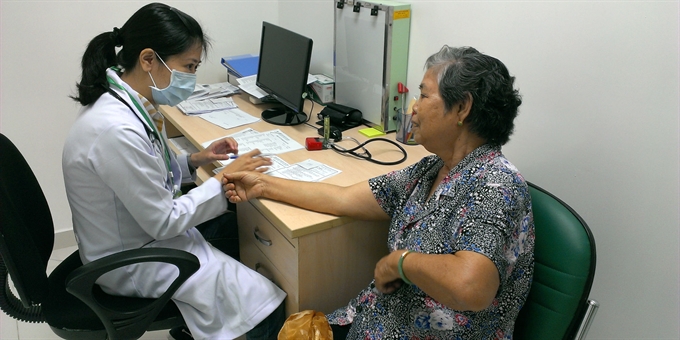 Society
Society

Family medical clinics in HCM City, established more than two years ago, have yet to achieve their goal of providing comprehensive primary care as they are still short of doctors.
 |
| An elderly receives health checkup at the Family Medical Practice Vietnam in HCM CIty. — Photo bacsigiadinhvietnam.vn |
Gia Lộc
HCM CITY — Family medical clinics in HCM City, established more than two years ago, have yet to achieve their goal of providing comprehensive primary care as they are still short of doctors.
The family medical clinics, set up to provide a closer, ongoing relationship with patients, are located at 20 district hospitals and 136 ward and commune health centres in the city.
The Ministry of Health launched the pilot family medical programme in eight provinces and cities with the aim of reducing patient overload and improving the quality of health examination and treatment.
Dr Nguyễn Hữu Hưng, deputy head of HCM City’s Department of Health, said that family medicine clinics around the world had provided effective comprehensive primary care to local residents.
However, many residents in Việt Nam are not familiar with the concept, he added.
At the clinics, patients are monitored more carefully and health records are maintained electronically.
In Việt Nam, patient overload at hospitals prevents doctors from spending a lot of time speaking to patients about their medical history and offering counselling on treatment and prevention.
“It is not sufficient. Patients should be offered more insightful and personal guidance and treatment over time instead of official hours like now,” Hưng said, adding that doctors at family medicine clinics should be seen as “the patients’ own doctor”.
Family doctors are doctors who provide primary and continuing care for entire families within their communities and address physical, psychological and social problems, according to the HCM City University of Medicine and Pharmacy.
They coordinate other specialised wards as needed.
Dr Trương Đoan Hạnh of the Bình Chiểu Ward’s Family Medical Clinic in Thủ Đức District said that the clinic often did not receive updates about patients who had been transferred from the clinic to city- or central-level hospitals for treatment of serious disease.
Hạnh also was not informed if these patients were told to return to ward clinics for periodic treatment and monitoring.
Patient trust
“Clinics at district hospitals (unlike wards and communes) are trusted by local residents and attract a large number of patients,” Hưng said.
For example, Thủ Đức District Hospital’s family medical clinic saw an increase of patients from 66 each day in 2013, when it opened, to 117 last year.
As of last year, the clinic’s doctors, who studied family medicine as a major at university, can treat many health problems without the assistance of doctors working at other wards in the hospital.
In 2013, the hospital’s clinic had 13 patients transferred to the hospital’s other wards for treatment. Last year, the figure fell to two cases.
Hưng said that 136 of 319 ward and commune health centres in the city have family medical clinics.
These centres are equipped with ultrasound machines and testing devices to provide primary care, he said.
The patients at the family medical clinics also receive advice on whether they should be transferred to specialised hospitals in the city.
Ward, commune clinics
Dr Nguyễn Đỗ Hồng Ngọc of Thủ Đức Hospital’s family medicine clinic, who is charge in of providing technical assistance for family medicine at wards in districts, said that, unlike district hospitals, trust in doctors at ward and commune health centres remained low.
For example, the Bình Chiểu Ward Family Medicine Clinic in Thủ Đức District saw an increase in patients from 480 in 2014 to 3,783 in 2015.
But the figure was modest compared to the ward’s population with 90,000.
According to one doctor at a family medical clinic in Bình Thạnh District’s 21 ward, most residents in the ward do not want to visit family medical clinics there.
Several other ward-level family medical clinics have admitted only three or four patients.
At a recent meeting with department and ward- and commune-level health centres, a representative of Tân Phú District’s ward health centre said that with only one doctor, it was difficult for the centre to set up a family medical clinic.
Solutions
To remedy the problem, district hospitals such as Thủ Đức and District 2 have sent their own doctors to assist at ward and commune clinics. They also offer training to doctors at the clinics.
Dr Nguyễn Minh Quân, the head of Thủ Đức Hospital, said: “They usually encourage patients who visit the hospital’s family medical clinics to go to clinics in their ward for their next health examination.”
Hưng, deputy head of the city’s Health Department, said that hospital’s leaders had done a good job in building their family medical clinic programmes.
“Like building a house, the best way is to create a strong foundation to set up family medical clinics at ward- and commune-level health centres,” he added.
Hưng said that more communication in the community was needed to ensure that residents were aware of the services provided by the clinics
“When residents see that their health is being taken care of, they will not visit specialised hospitals or city-level hospitals unless the situation is serious,” Hưng said.
At a recent conference on family medical clinics held in the city, Dr Nguyễn Quý Tường, deputy head of the central government’s Medical Examination and Treatment Department, said that all doctors at ward- and commune-level health centres this year would receive additional training in three-month courses in family medicine.
The Ministry of Health will also offer more preferential policies to attract properly educated personnel and doctors to work at family medicine clinics. — VNS




